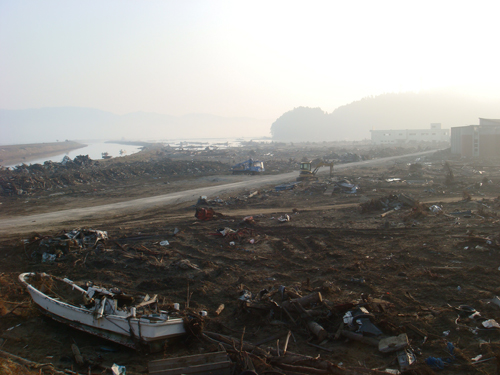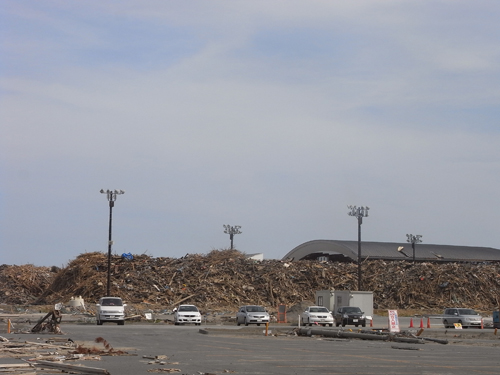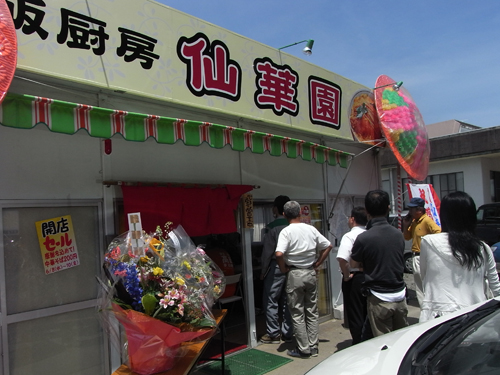8/14から19にFabLabの国際会議、Fab7がペルーのリマで行われました。
日本からはFabLabJapanの田中浩也先生(@Hiroyeah)がプレゼンテーションを行うセッションがあり、被災地を訪れた印象とFabLabの可能性を話して欲しいという依頼を頂き、メッセージを送らせて頂きました。(英訳は田中先生によるものです。ありがとうございます。)
–
FAB7参加の皆様へ
3.11に発生した東北関東大震災の被災地を訪れた印象、それからFabLabやものづくりがどのように支援出来るのか、ということを私なりに伝えさせて頂こうと思います。
For all participants at FAB7,
I’d like to tell you how I felt when I visited the damaged (by the disaster earthquakes and tsunami) areas in Japan, and a little bit more about how Fab Labs and Fab Labbers could support from now on.
被災地を訪れた印象
今回の震災では東北沿岸、数100kmに渡る範囲で被害を受けています。被災地と一言でいうには、あまりにも広く、私が訪れたのは、そのうちのいくつかの町に過ぎません。具体的には、4月中旬に石巻に、6月中旬に岩手の南側の陸前高田や大船渡を訪れました。
石巻では河北町という町にあるボランティア団体を通じて訪れました。河北町は、小学校の7割の児童が津波にさらわれてしまったという、本当に辛い経験をしている町です。ここで感じたことを、説明するのは難しいのですが、海から5km以上離れた場所まで被害を受け、その被害の深さと広がりに圧倒されました。そのなかでも印象に残っているのは、そのボランティア団体と現地の人との関係です。
My personal impressions on damaged areas in Japan
Damaged areas by the disaster are very large. The range covers over hundreds kilometers, particularly along with long coasts in North East areas in Japan. Nobody can visit all the cities in such large areas. I personally could visit some of the cities- Ishinomaki (in the middle of April) and Rikuzden Takada and Ofunawatari located in the south part of Iwate prefecture (in the middle of June). In Ishinomaki city, there is a town called KawaKitacho, sadly where 70% of pupils at elementary school had been missing. It’s hard to express my feelings, however, I just can say I was very struck by the reality, what happened there and how deep and large the influence was. Even under such situations, I found one hope for the future. It is the relationship between volunteer staffs from outside the city and people having lived in the city.

ボランティアたちは津波の被害にあった家屋からヘドロを出す作業を主に行っていたのですが、現地の方からの信頼が厚く、夜は飲食店を営んでいたご主人がボランティアのために、ささやかな食材しかない状況ではあるのですが、感謝の気持ちをこめて料理をしてくれたり、ボランティアのために自宅のお風呂を使って欲しいという申し出がありました。彼らの方が辛い状況のはずなに、外から来た者を気遣う気持ちに触れて、思わず涙が流れました。
Volunteer staffs were working on removing sludge from the inside of housings which was broken by Tsuhami. People who lived in the city kindly cooked for them even when ingredients are limited. They also offered to give them the use of private baths. Despite people there seemed to be very despaired and exhausted, they did their best with cordial actions for people coming from outsite. I couldn’t stop crying.
外から来た者には、確かにそこで生活する人の悲しみや苦しみを本当の意味では理解することはできません。しかし、むしろ、外から来た者であるからこそ活動的でいられるし、困難に立ち向かうことができるということがあることを実感しました。私達が行ったことは、実益としては小さなことだったと思います。それでも、現地の人を少し勇気づけ、困難に立ち向かうのは、彼らだけではないという気持ちの繋がりのようなものを与えられたのではないかと思っています。
It is impossible for people from outside of the damaged areas to perfectly understand tortures and sadness of people living there. However, people from outside of the damaged areas could work earnestly and give energy and courage, and take actions to confront with difficulties. That’s what I realized there. What we did there was tiny in practical sense, however, we could give some kinds of braveness to people living there, and make cordial connections among people.

6月に訪れた岩手では、仮設住宅ができはじめ、被災者の自立や自治体の復興計画が提示された段階で、緊急救援フェイズから復興フェイズへとスタートを切ろうとしていた時期です。私が訪れた岩手南部沿岸の気仙地方の被害状況は、凄まじいものでした。なかでも陸前高田の被害は著しく、4階建ての建物よりも高く積まれたがれきの山がいくつもありました。高田では車で走っても走ってもどこまでも被害が続いています。町のすべてが失われているので、復興とはいうものの、ここに経済が戻ってくるのか?想像することができませんした。
そんななかで、ちょうど私達が訪れた日に、陸前高田ではじめて再開された飲食店を見つけることができました。外側まで列ができるほどの盛況ぶりで、復興に向けた小さな兆しをみたような気がしました。今も大きな課題となっているのが、漁業や農業を再開できない人々の雇用の問題です。働くということは、経済的な自立とともに、人が生きる尊厳を与えます。養殖の海産物は、育てて売る事ができるまで、3年程度の時間が必要です。その間の雇用をどうしていくのか、さらに地域の経済をどう再建していくのかは、本当に大きな問題です。
After that, I visited Iwate Prefecture in June. At that time, temporal housings were being built, and proposals for reconstructing the cities were widely disseminated. It was the beginning of turning point from “emergency” phase to “reconstructing” phase. The damage of Kisen area, located in south part of Iwate prefecture, was beyond our thought. Especially Rikuzen-Takada was terribly damaged. Huge heaps of rubble, whose height was beyond the 4th floor of buildings, remains even two months after the earthquake. We couldn’t find any border between damaged areas and non-damaged areas. Everything was missing in the huge area. I couldn’t imagine when and how economy will come back there.
The only hope I found was the small restaurant which could open again the first in Rikuzen Takada. There was a long queue of people who had been longing for the restaurant. The biggest issue in that area was how to hire people who had lost their jobs on fishery or agriculture. People can get various values form working- not only their economical independence but also their self-esteem in the society. Aquafarming needs at least three years from cultivation to selling. How can they survive during such period? How to rebuild local economy? Those are critical issues under current situations.

FabLabやものづくりにできること
FabLabやものづくりが貢献できることはいくつかあると思います。1つは住環境の改善。FabLabの機材やノウハウを活かしながら、無機質な仮設住宅に彩りを与えることができるのではないかと思います。仮設住宅を巡回しワークショップを行いながらそれを手伝って行くというような活動があるのではないでしょうか。2つめは小さな雇用を生みだすことです。地域の人が関われるような生産手段を構築し、世界に対して何らかの製品を販売し収益を獲得する、フェアトレード的なモデルです。3つめは、地域のコミュニティセンターのような形で地域で必要とするものを作ることを支援していくような形があると思います。
What Fab Lab/Maker can do
I have some ideas on what Fab Lab/ Maker can contribute. The first idea is improvement of housings. I think it’s possible to attach ornaments and put furniture (made and fabricated by Shopbots and other fablab facilities) to only-for-functional current temporal housings. It’s more effective if Mobile FabLab can move from here to there, having workshops on making ornaments and furniture. The second is to involve people in micro business. If we gave some machines for making things to them, they could make products and finally sell them to people all over the world, and hopefully get money. It’s like a model of fair-trade. The third is to set up community-oriented Fab Lab, particularly focused on making and giving the useful products which satisfy the needs and demands of people living there.
ものを作るということは、苦労とともに達成感のある行為です。こうした精神的な充足を積み重ねて行く作業は、もう一度被災地が自信を取り戻して行く時に必要な作業なのではないかと感じています。
また、東北に多い漁師や農家は、身の回りにある資材を使って必要とするものを作ってしまう、ブリコラージュを巧みに行います。FabLab Japanのディスカッションにある使う人が作る、ということを、生活環境と溶け込んだ形で行っているネイティブたちが、3次元プリンターやレーザーカッターといった新しいものづくりに携わっていくというところに、「つくりかたの未来」があるのではないかという妄想も広がります。
It’s worth while making things. It takes a lot of time, however, it gives us a lot of satisfaction and funs instead. People can get not only physical convenience but also mental achievement from making things. That is what now people need to have, for getting over many difficulties, and for taking confidence over again. Furthermore, people in north-east areas are very good at making things even from limited resources with hands-craft skills. That’s the very good example of ‘bricolage’. I think they are working in their own DIY style. Fab Lab could share the similar attitude with them. I personally expect how they will use 3d-printers and laser cutters, and apply them to the current situation. It is going to be “the future of making”, isn’t it?
最後に、あるNGOの方から聞いた言葉を紹介して終わります。日本語では、文化形成に影響を与える地域環境を風土と言います。風土は「風」と「土」という言葉からできています。風は外から流れるくるもの、土はその地域にもともとあるものです。風土とは、外からの新しい風と土地固有のものから生まれるものだ。というお話を伺いました。
使う人が作る社会、この新旧から新しい風土を想像することはそれほど突飛なことでも無いように思われるのです。
Let me end with one story which I heard from a person in NGO. In Japanese, local environment, that can be distinguished by cultural uniqueness, is called “風土”. “風土” consists of two characters “風(wind)” and “土(land)”. “Wind” implies what flows into the place, and “land” implies what keeps existing there. The genuine abundance of local environment can be emerged only from the best harmony between “wind” and “land”. I think Fab Lab can take a part of making such a great harmony, in damaged area in the future.
Yusuke Okamura
岡村祐介